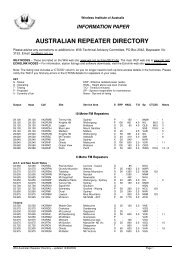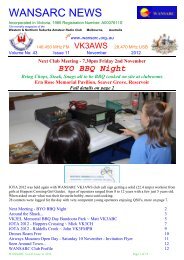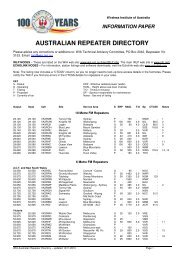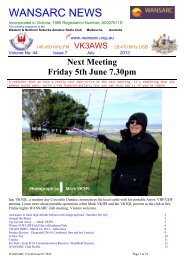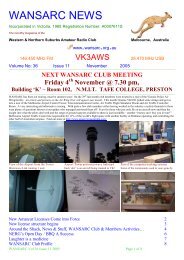WANSARC Vol 38 Issue 09 2007.pdf - Western & Northern Suburbs ...
WANSARC Vol 38 Issue 09 2007.pdf - Western & Northern Suburbs ...
WANSARC Vol 38 Issue 09 2007.pdf - Western & Northern Suburbs ...
You also want an ePaper? Increase the reach of your titles
YUMPU automatically turns print PDFs into web optimized ePapers that Google loves.
Page 2 <strong>WANSARC</strong> NEWS September 2007<br />
The Restless Sun PART 1 Past and Future of the Solar Cycle by Peter VK3YSF<br />
We all find comfort with the cyclical and predictable events in<br />
nature like sunrise, the seasons and for radio hams the solar cycles.<br />
The solar cycle is one of those natural rhythmic cycles that<br />
has reliably peaked every eleven years or so. The cycles may<br />
vary in intensity and have been as short as nine years to as long<br />
sixteen, but they always eventually arrive and that is the truth for<br />
anyone giving them attention.<br />
What are the affects beyond radio propagation and how reliable<br />
are these cycles, what if they stopped or dramatically changed in<br />
their intensity or duration, what would it mean<br />
The solar cycle<br />
The solar cycles are generally thought of as the cyclical rise and<br />
fall in the calculated sunspot number over time. The sunspot<br />
number is calculated by multiplying the number of groups of sunspots<br />
by ten and then adding this product to the total count of<br />
individual spots.<br />
The sunspot number is a way of gauging the level of solar activity or solar radiation which has a direct effect on<br />
the degree of ionization in the upper atmosphere and ultimately determines the degree of path refraction of high<br />
frequency radio waves. Solar radiation, acting on the different compositions of gasses at various heights of the<br />
atmosphere, generates layers of ionization and therefore it follows that the number of sunspots can help predict<br />
conditions on radio HF bands.<br />
The point of highest sunspot activity during this cycle is known as Solar Maximum, and the point of lowest activity<br />
is Solar Minimum.<br />
The sunspots will appear in pairs in a more or less east-west alignment, the eastern sunspot of the pair will be of<br />
one magnetic pole say north and the other western sunspot of the pair will be magnetic south. In the other hemisphere<br />
of the Sun the opposite will be true. This situation will reverse from one solar cycle to the next. Also sunspots<br />
will be near the solar equator towards the end of a given cycle and towards the poles at the beginning of the<br />
next.<br />
The detection of the first opposite magnetic polarity sunspots compared to proceeding cycle’s sunspot polarity<br />
and the observation of high solar latitude sunspots will indicate the beginning of the new cycle, cycle 23 ends cycle<br />
24 begins.<br />
A key indicator that the solar maximum has arrived is that the sun’s magnetic poles flip from north to south that is<br />
the Pole that is magnetic north becomes magnetic south and the Pole that is magnetic south becomes magnetic<br />
north. What this means is that a complete solar cycle, when the Sun’s poles are back to their original magnetic<br />
pole is in fact about 22 years in length.<br />
11,400 years of sunspot history<br />
A really neat piece of research gives a view of what the sun has been doing over more than 11,000 years or as far<br />
back as the last major ice age event.<br />
The Earth is constantly being irradiated by cosmic rays from deep space and these rays produce in the atmosphere<br />
a material known as carbon 14 which is absorbed by trees among other things. Trees even dead trees retain<br />
a record of the levels of carbon 14 being produced over a very long period of time. Charged particles from the<br />
Sun which are greater during periods of high sunspot activity repel the cosmic rays and therefore the more sunspot<br />
activity there is the less carbon 14 is recorded in the tree rings.<br />
Using the carbon 14 level records the sunspot number estimates have been pushed back as far as 11,400 years<br />
into the past and reveal that the current high level of solar activity has not occurred for well over 8,000 years. See<br />
figure 1.



